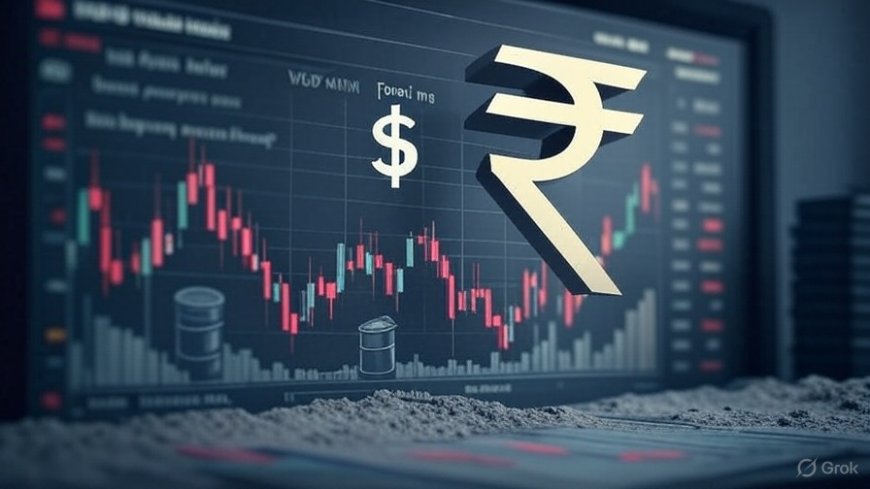Rupee Slips Toward One-Month Low as Stronger Dollar and Weak Inflows Fuel Currency Pressures
The Indian rupee is nearing a one-month low amid weak foreign inflows and a resurgent dollar index. Analysts warn of persistent volatility driven by global economic cues and domestic market uncertainties.

Rupee Slips Toward One-Month Low as Stronger Dollar and Weak Inflows Fuel Currency Pressures
Mumbai | July 21, 2025 — The Indian rupee continued its downward drift on Monday, edging close to a one-month low against the U.S. dollar. The slide, triggered by weak foreign portfolio inflows and a strengthening dollar index, has raised concerns over the near-term stability of India’s currency and its broader macroeconomic implications.
At the time of writing, the rupee was trading at ₹83.61 per U.S. dollar, a level not seen since late June. The currency has depreciated nearly 0.6% in the last five trading sessions, with traders closely watching global bond yields, capital flows, and central bank signals.
What’s Driving the Rupee’s Decline?
1. A Resilient Dollar Index
The U.S. dollar index (DXY), which tracks the greenback’s performance against a basket of six major currencies, has firmed up to above 106.2, its strongest level since mid-May. This rise has been largely attributed to hawkish signals from the U.S. Federal Reserve and stronger-than-expected U.S. retail sales data.
“The dollar index’s resurgence is prompting a flight to safety, especially with market expectations of a delayed Fed rate cut,” said Radhika Rao, economist at DBS Bank.
When the dollar strengthens, emerging market currencies like the Indian rupee typically come under pressure, as global investors rebalance portfolios toward dollar-denominated assets.
2. Weak Portfolio Inflows
Foreign institutional investors (FIIs) have turned cautious, with net outflows recorded in recent sessions. According to NSDL data, FIIs pulled out nearly ₹4,200 crore from Indian equities last week, citing valuation concerns and global risk-off sentiment.
Meanwhile, bond market inflows remain tepid despite India’s upcoming inclusion in the JP Morgan Government Bond Index-Emerging Markets (GBI-EM) in 2026. The anticipated positive sentiment has not yet materialized in significant flows.
3. Rising Crude Oil Prices
Brent crude prices remain elevated near $84 per barrel, a level that poses fiscal risks for oil-importing countries like India. A stronger oil bill usually widens the current account deficit and adds stress to the rupee.
“Any surge in oil prices instantly reflects on the rupee’s stability, especially when import cover weakens,” explained Ajay Manglunia, Managing Director, JM Financial.
4. RBI Intervention Signals Limited
The Reserve Bank of India (RBI) is closely monitoring the currency, but there’s been little direct intervention in recent sessions. Market analysts believe the central bank may prefer allowing the rupee to adjust gradually rather than burn forex reserves to hold a specific level.
India’s forex reserves currently stand at $644.1 billion, as per the RBI’s weekly data—a healthy buffer, but one that the central bank may use cautiously to manage volatility rather than target fixed levels.
Market Sentiment and Analyst Reactions
Market participants are increasingly pricing in currency volatility, especially amid uncertainties around global interest rates, China’s weak economic recovery, and geopolitical risks in the Middle East and Eastern Europe.
According to a recent Bloomberg poll, nearly 70% of currency strategists expect the rupee to remain under mild depreciation pressure for the remainder of Q3 2025.
“We believe the rupee will hover in the ₹83.50–₹84.20 range unless there is a reversal in the dollar trend or a sharp rise in foreign inflows,” noted Gaurav Garg, Head of Research at CapitalVia Global Research.
Impact on the Indian Economy
1. Importers to Face Higher Costs
As the rupee weakens, companies reliant on dollar-based imports—particularly in energy, technology, and pharmaceuticals—will face higher costs. This could marginally impact corporate earnings and consumer pricing.
2. Exporters May Gain Slight Edge
Exporters, especially in the IT services, textile, and agri-commodities sectors, could benefit in the short term, as a cheaper rupee makes Indian goods more competitive globally.
3. Inflationary Concerns Resurface
While India’s CPI inflation remains under control at 5.1%, a persistently weak rupee could reintroduce inflationary pressures through more expensive imports, particularly crude oil and electronic components.
For detailed macroeconomic impact analysis, refer to RBI’s Monthly Bulletin.
What Investors Should Watch Next
-
Federal Reserve Meeting (July 31st): Any signal of rate hikes or delayed cuts could further strengthen the dollar.
-
India’s Q1 FY26 GDP Data (due in August): Could influence market confidence and FII interest.
-
Crude Oil and Gold Prices: Volatility in these commodities can act as external stressors for the rupee.
Technical Outlook
The rupee’s immediate resistance is placed at ₹83.25, while the next support lies near ₹84.10. Traders expect thin volumes ahead of the Fed's guidance, with high sensitivity to foreign fund movements.
For daily technical updates, Reuters India Forex Coverage remains a reliable source.
Government and RBI’s Stance
While the Ministry of Finance has not issued an official statement, sources suggest that there is no alarm within North Block regarding the rupee’s performance. The RBI, for its part, is expected to maintain its focus on inflation control and macroeconomic stability rather than artificial currency management.
“A flexible exchange rate is in line with India’s long-term currency management policy. Interventions, when necessary, are aimed at controlling excessive volatility, not levels,” said a senior RBI official.
Conclusion
As the Indian rupee edges toward a one-month low, currency watchers remain focused on a delicate interplay of global dollar strength, tepid foreign inflows, and domestic economic indicators. While short-term pain may persist, the structural fundamentals of the Indian economy remain intact.
With forex reserves healthy and India’s inclusion in global bond indices ahead, the rupee is not in crisis—but caution and vigilance are warranted in the months ahead.


















































